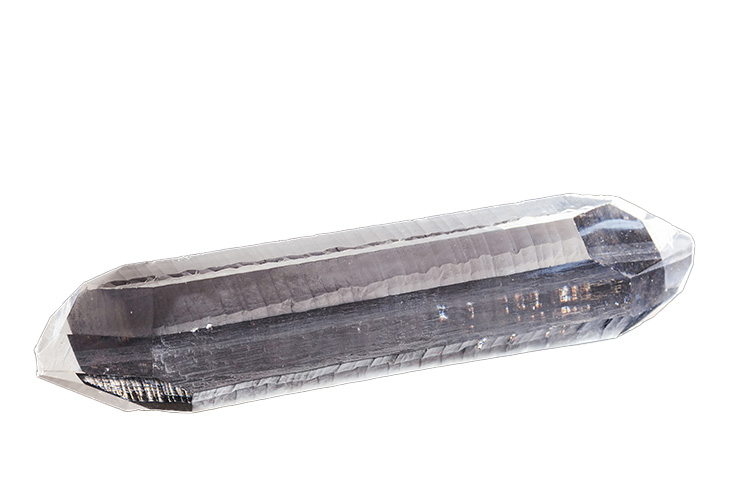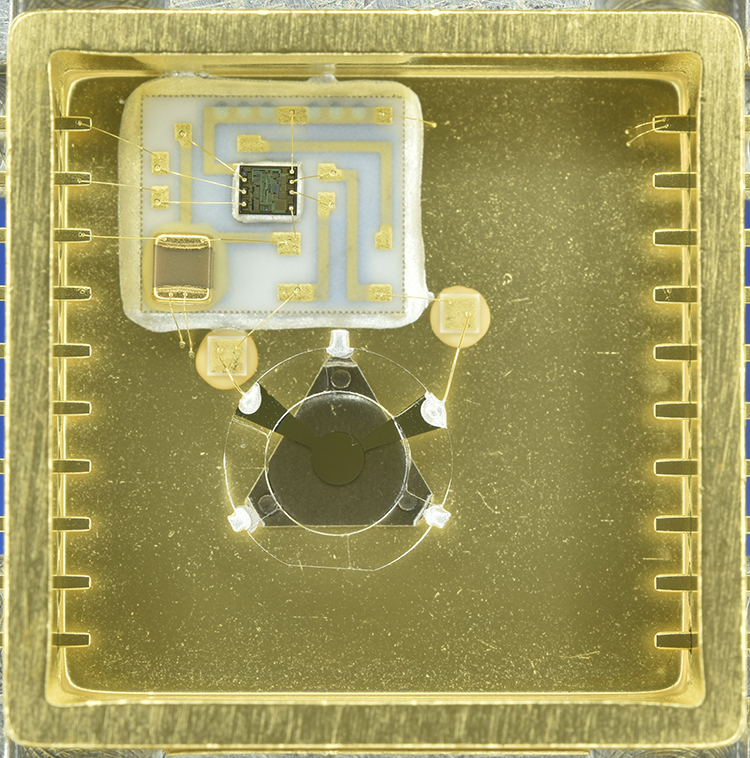
It all starts with a synthetic crystal bar like this one. Then it takes a precise and time-consuming process to produce baseplated crystal disks tailored to precise frequencies
The unique and most critical component of every precision quartz crystal oscillator is the quartz crystal itself. Quartz is a crystalline form of silicon dioxide, but what exactly does a quartz crystal for use in electronics look like? It is a small sliver of very thin quartz that resonates at a high frequency, typically between one million cycles per second to 100 million cycles per second. The thin sliver of quartz is plated with metal electrodes on its surfaces and is attached with epoxy or wire bonded to a mounting structure. For most clock oscillators, the “open blank” quartz resonator is sealed along with its associated oscillator circuitry in a hermetically sealed package, like the one shown in the figure below. For the most precise oscillators, the quartz resonator is sealed all by itself in a hermetic stand-alone package, before being attached. It is then sealed hermetically along with its circuitry, thus creating a doubly hermetically sealed environment for the crystal.

So how is the crystal resonator itself manufactured?
Quartz is a naturally occurring six-sided crystalline form of silicon dioxide, but the raw materials we now use in electronics are slow-growth synthetic quartz bars. These quartz bars are grown in autoclaves under high pressure and high temperature. In the autoclaves, raw nutrient quartz is dissolved and then deposited on ultra-pure quartz “seeds.” Natural quartz forms within the earth at high pressures and temperatures, however, the process takes millions of years and the natural quartz contains some contaminates and impurities. Modern, synthetic, high purity quartz bars are extremely high Q and extremely low in impurities and defects.
The first step in the manufacturing process is to determine the exact orientation of the quartz crystal lattice of each bar by shooting an x-ray beam into the bar at an exact pre-determined angle, and then measuring the reflected x-ray beam that bounces off of an atomic crystal interface. The reflected beam is detected and is known as a Bragg reflection angle which measures the exact orientation of the crystal lattice. This orientation angle thus determines the exact way the quartz’s piezoelectric effect will cause it to behave over temperature.
Afterwards, the bars are cut by sawing them at the proper angle, producing rectangular blanks that are then sawed into squares that will be subsequently rounded into individual round blanks. But before the rounding process, it is necessary to carefully re-do the Bragg reflection angle measurement of each square blank so as to characterize its exact angle of cut which will determine its piezoelectric performance and usability for specific applications. After the rounding process, it is very difficult to get an accurate enough Bragg angle measurement, so subsequent yields are highly dependent on the precision and reliability of this last x-ray characterization of each blank before it is rounded.
After rounding, the quartz crystal blanks are lapped in several successively finer abrasive slurry mixes in order to very gradually reduce the thickness of the blank, thus lowering the frequency, which depends on the thickness. This is done in progressive steps using finer and finer abrasives to make the surface finish of the quartz blank ultimately be as smooth and flat and defect free as possible. If only a course abrasive were used, the blank could be quickly lapped down to the desired thickness and frequency, but the surface finish would also be rough and coarse, with the surface of the blank having imperfections about the size of the coarse abrasive particles used. On the other hand, if only a very fine abrasive were used, it would take an extremely long time to reach the desired thinness and frequency. So, the optimum method starts with a coarse abrasive and then each successively finer abrasive removes at least as much thickness as the size of the previous abrasive’s particles, ultimately reaching the desired frequency and surface smoothness.
Finally, after the last abrasive slurry lapping stage, the crystal blanks are polished using an extremely fine-grained polish mixture, usually cerium oxide. This makes the surface so smooth and defect-free that the previously opaque crystal blanks become transparent. Last of all, the blanks are then etched using an acidic or basic bath to make the surface even finer. The blanks are then cleaned usually using deionized water and a special soap solution, then rinsed repeatedly in very clean deionized water. At this point the blanks are ready to be baseplated.
What is Baseplating?
Baseplating refers to the deposition of metal electrodes on the quartz. The baseplating must be done in an ultra-clean vacuum chamber. Precise areas on the blank are masked leaving the areas intended for the metal electrodes exposed. Then very accurately controlled amounts of the appropriate metal are vaporized in a high vacuum and are thus deposited on the quartz crystal blank, lowering the blank’s frequency, because the metal electrodes add mass to the crystal thus altering its effective thickness. The crystal blanks are held a little bit higher in frequency than the desired target, in order to leave room for a more exact final gold adjustment. Keep in mind that there are many important details, such as the diameter of the quartz blanks, the diameter of the metal electrodes, the thickness of the electrodes, the kind of metal used, and etc.
After baseplating, the crystals are ready to be attached either to a stand-alone crystal holder or to a hybrid clock oscillator holder, then final frequency is adjusted by vacuum deposition of a very small amount of gold and then sealed in a permanent ultra-clean crystal package or clock oscillator package, either in a vacuum or else a pure Nitrogen-Helium atmosphere.
Excellence is the Product of Experience
Production of space-qualified crystal oscillators requires precision and expertise that’s only found in companies like Q-Tech which have decades of experience.
Click here to download Q-Tech’s Activity Dips Application Note
testing